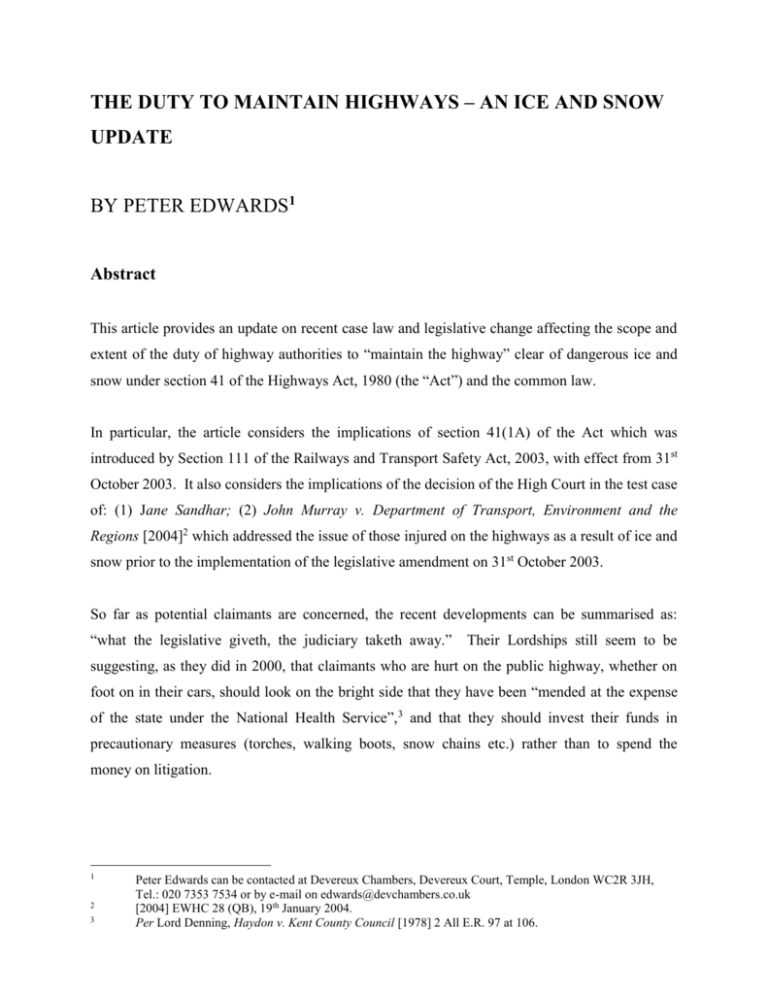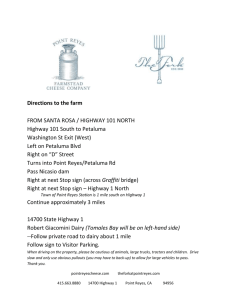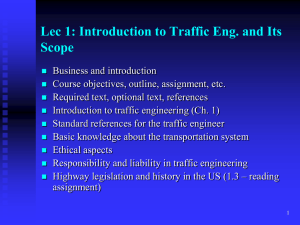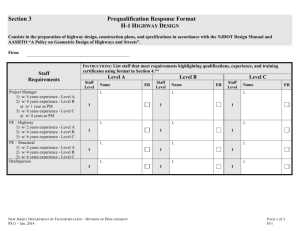article here
advertisement

THE DUTY TO MAINTAIN HIGHWAYS – AN ICE AND SNOW UPDATE BY PETER EDWARDS1 Abstract This article provides an update on recent case law and legislative change affecting the scope and extent of the duty of highway authorities to “maintain the highway” clear of dangerous ice and snow under section 41 of the Highways Act, 1980 (the “Act”) and the common law. In particular, the article considers the implications of section 41(1A) of the Act which was introduced by Section 111 of the Railways and Transport Safety Act, 2003, with effect from 31st October 2003. It also considers the implications of the decision of the High Court in the test case of: (1) Jane Sandhar; (2) John Murray v. Department of Transport, Environment and the Regions [2004]2 which addressed the issue of those injured on the highways as a result of ice and snow prior to the implementation of the legislative amendment on 31st October 2003. So far as potential claimants are concerned, the recent developments can be summarised as: “what the legislative giveth, the judiciary taketh away.” Their Lordships still seem to be suggesting, as they did in 2000, that claimants who are hurt on the public highway, whether on foot on in their cars, should look on the bright side that they have been “mended at the expense of the state under the National Health Service”,3 and that they should invest their funds in precautionary measures (torches, walking boots, snow chains etc.) rather than to spend the money on litigation. 1 2 3 Peter Edwards can be contacted at Devereux Chambers, Devereux Court, Temple, London WC2R 3JH, Tel.: 020 7353 7534 or by e-mail on edwards@devchambers.co.uk [2004] EWHC 28 (QB), 19th January 2004. Per Lord Denning, Haydon v. Kent County Council [1978] 2 All E.R. 97 at 106. The statutory provisions Section 41(1) of the Highways Act, 1980, provides as follows: “The authority who are for the time being the Highway Authority for a highway maintainable at the public expense are under a duty … to maintain the highway.” Section 329 of the Act provides the unhelpful clarification that “maintenance includes repair and “maintain” and “maintainable” are to be construed accordingly.” Section 58(1) of the Act provides a defence to the absolute duty created by Section 41(1) as follows: “In an action against a highway authority in respect of damage resulting from their failure to maintain a highway maintainable at the public expense it is a defence … to prove that the authority has taken such care as in all the circumstances is reasonably required to secure that the part of the highway to which the action relates was not dangerous to traffic.” Ice and snow – A “Goodes” update In a previous article that I wrote for the Journal of Personal Injury Law (The Duty to Maintain Highways – Seasonal Cheer from the House of Lords? [2000] J.P.I.L. Issue 4/00, page 228) I considered the decision of the House of Lords in Goodes v. East Sussex County Council [2000]4 on the statutory duty (or rather the lack of statutory duty) on a highway authority to clear dangerous ice and snow from the highway. There have been a number of very significant developments since that article. The Facts The facts of the case were that Mr. Goodes had been driving his car along a road maintained by East Sussex County Council when it skidded on black ice in the road and crashed into a bridge. 4 [2000] 1 WLR 1356. Mr. Goodes was seriously injured. At the time of Mr. Goodes’ accident the county council had despatched a gritting lorry to the area but it had not yet reached its destination. The claim for negligence against the county council had not been pursued at trial. The claim was, therefore, solely under Section 41(1) of the Act. The issue for consideration by the House of Lords was whether “section 41(1) is confined to keeping the highway in good repair or whether it also obliges the council to keep it free of ice.” The Courts below the House of Lords had concluded that they were bound by authority to find that section 41(1) imposed the wider duty. The decision The decision of the House of Lords in Goodes was as follows: “A highway authority’s duty under Section 41(1) of the Highways Act 1980, to maintain the highway was an absolute duty to keep the fabric of the highway in such good repair as to render its physical condition safe for ordinary traffic to pass at all seasons of the year. But it does not include a duty to prevent the formation of ice or remove the accumulation of snow on the road. Accordingly, the highway authority was not in breach of its statutory duty and was not liable for the [claimant’s] accident.” Their Lordships concluded that unless and until Section 41 was altered by Parliament, a claimant who had an accident as a result of ice or snow on the public highway could not rely on Section 41. The legislative change Since, rather than because of, my previous article, the legislature has seen fit to intervene in this area. Parliament has acted as the claimants’ George to the House of Lords’ dragon. Section 41(1A) of the Act (which was inserted by the Railways and Transport Safety Act, 2003, section 111) now provides as follows: “In particular, a highway authority are under a duty to ensure, so far as is reasonably practicable, that safe passage along a highway is not endangered by snow or ice.” There are a number of significant points that are worthy of note arising from the amendment. First, section 41(1A) (in keeping with section 41 in general) does not create an absolute duty on a highway authority. The duty is only to ensure that users of the highway are not endangered by snow or ice “so far as is reasonably practicable.” Ironically, Mr. Goodes, whose case prompted the legislative change, may still not have received compensation even after the amendment. It is to be recalled that in Mr. Goodes case the gritting lorry had already been dispatched by the county council. It simply got there too late. Arguments as to “reasonable practicability” would have been difficult for Mr. Goodes in those circumstances. Second, the logic behind the decision in Goodes would apply equally to a number of other commonly encountered situations. For example, leaves that fall onto the highway in Autumn. The leaves obviously would not affect the “fabric of the highway” such as to give rise to a need to repair the same. All that is required is for the road or pavement to be swept in the same way that all that is required when snow or ice has fallen is for the same to be cleared. The legislative amendment does not affect the duty of the highway authority to clear leaves. It will probably take a claimant who is seriously injured have fallen or skidded on leaves to provoke such an amendment. In the meantime it seems clear that section 41 will not apply to such cases. Third, the change was enacted with effect from 31st October 2003 and, obviously, only applies to accidents occurring after that date. What then is the position of claimants who were injured as a result of snow or ice on the highway between 2000 (when Goodes was decided) and 31st October 2003 (when the amendment was inserted)? This is an issue that was considered by the High Court (Newman J. presiding) in the case of: (1) Jane Sandhar; (2) John Murray v. Department of Transport, Environment and the Regions [2004].5 5 [2004] EWHC 28 (QB), 19th January 2004. The Sandhar decision Sandhar was expressly taken as a test case in respect of accidents occurring before the commencement of the amendment to the Act with effect from 31st October 2003 in order to consider whether a highway authority was under a common law duty of care to remove ice or snow or to prevent it from forming on roads maintained by it. Facts The facts of the case were that Mr Murray had been killed in a road traffic accident when his car skidded off an icy trunk road. The road had not been salted at the time even though the Department of Transport’s trunk roads maintenance manual required that such salting be carried out following weather reports warning of ice (as had been given on the day before Mr Murray’s accident). The decision The Court was bound by Goodes to conclude that the Claimants were unable to rely on the statutory duty under section 41 of the Act. Thus, the issues were whether a highway authority was under a common law duty of care and, if so, whether the Department was in breach of that duty. The latter point would have been reasonably straightforward for the Claimants since Newman J. concluded that the Department had “not properly implemented” its own winter maintenance programme. The question was: did it owe a duty of care to do so? The answer from the Court was a resounding: NO. Newman J. held as follows: “[The highway authority] was not under a duty of care at common law to take steps to remove ice or prevent ice forming on roads maintained by it. Whilst frost gave rise to a foreseeable risk of danger and physical injury to road users, the risk was there for all to see and anticipate, including the deceased. The mere existence of the maintenance manual did not make it reasonable to impose a duty on [the highway authority] to pay compensation to those who were physically injured because the scheme was not properly implemented. Nor did the manual’s existence create a sufficient relationship of proximity between [the highway authority] and the deceased to give rise to a duty of care in the circumstances.” Analysis of decision There was no appeal lodged on behalf of the Claimants. That was almost certainly a wise move given the general approach of the appeal courts to highways cases. However, as an expressly stated test case the reasoning adopted by Newman J. will be highly persuasive to any Court hearing a similar case in the future. Thus, subject to appeal to the Court of Appeal, the position of a claimant injured on ice or snow on the highway before 31st October 2003 is very bleak. No section 41 duty arises on a highway authority to clear ice and snow even if it creates an obvious danger. No common law duty of care arises even if the highway authority has adopted a programme for clearing ice/snow and has failed to properly implement the same. In short, the view of the Courts is that snow and ice is a “risk for all to see and anticipate.” The same logic would seem to apply to other naturally occurring events such as leaf fall in Autumn. Conclusion The “novel ways to formulate a claim” that I suggested in my previous article in order to seek to avoid the implications of the Goodes decision in appropriate cases seem to have been firmly rejected. It is hard to see that any avenue of redress remains since Parliament is highly unlikely now to consider any retrospective change to section 41. Claimant solicitors will need to be aware of the severe limitation of claims in such cases where ice and snow are involved until 30 th October 2006 when the limitation period for accidents before 31st October 2003 will expire in any event. For cases involving, for example, leaves and moss, the obstacles in the way of pursuing a claim will remain even after that date.







